The Q-Tube-Assisted Green Sustainable Synthesis of Fused Azines: New Synthetic Opportunities via Innovative Green Technology
Abstract
:1. Introduction
2. Results and Discussion
3. Materials and Methods
4. Conclusions
Supplementary Materials
Author Contributions
Funding
Institutional Review Board Statement
Informed Consent Statement
Data Availability Statement
Acknowledgments
Conflicts of Interest
References
- International Renewable Energy Agency (IRENA). REmap 2030: A Renewable Energy Roadmap, Summary of Findings. June 2014, Abu Dhabi (2014). Available online: https://www.irena.org/remap/IRENA_REmap_summary_findings_2014.pdf (accessed on 14 December 2015).
- International Energy Agency. World Energy Outlook 2015; ISBN 978-92-64-24365-1. Available online: http://www.iea.org/Textbase/npsum/WEO2015SUM.pdf (accessed on 21 October 2023).
- Dechema Gesellschaft für Chemische Technik und Biotechnologie e. V (DECHEMA); International Energy Agency (IEA); International Council of Chemical Associations (ICCA). Technology Roadmap. 2013. Available online: https://www.iea.org/publications/freepublications/publication/Chemical_Roadmap_2013_Final_WEB.pdf (accessed on 14 December 2015).
- Bedenik, N.O.; Zidak, N. green economy supported by green chemistry. Eurasian J. Bus. Manag. 2019, 7, 49–57. [Google Scholar] [CrossRef]
- Polshettiwar, V.; Varma, R.S. Microwave-assisted organic synthesis and transformations using benign reaction media. Acc. Chem. Res. 2008, 41, 629. [Google Scholar] [CrossRef] [PubMed]
- Kappe, C.O. Controlled Microwave Heating in Modern Organic Synthesis. Angew. Chem. Int. Ed. 2004, 43, 6250–6284. [Google Scholar] [CrossRef] [PubMed]
- Al-Zaydi, K.M.; Saleh, T.S.; Alqahtani, N.F.; Bagazi, M.S. Bis(pyridine)enaminone as a Precursor for the Synthesis of Bis(azoles) and Bis(azine) Utilizing Recent Economic Green Chemistry Technology: The Q-Tube System. Molecules 2023, 28, 2355. [Google Scholar] [CrossRef] [PubMed]
- Illustrations Together with Exhaustive Technical. Available online: http://www.qlabtech.com (accessed on 3 January 2023).
- Nacca, F.G.; Merlino, O.; Mangiavacchi, F.; Krasowska, D.; Santi, C.; Sancineto, L. The Q-Tube system, a nonconventional technology for green chemistry practitioners. Curr. Green Chem. 2017, 4, 58–66. [Google Scholar] [CrossRef]
- Wurche, F.; Klärner, F.-G. The Effect of Pressure on Organic Reactions: Basic Principles and Mechanistic Applications in High Pressure Chemistry: Synthetic, Mechanistic, and Supercritical Applications; Wiley-VCH Verlag GmbH: Winheim, Germany, 2002; pp. 41–96. [Google Scholar]
- Ball, D.; Key, J. Introductory Chemistry, 1st ed.; BCcampus: Victoria, BC, Canada, 2014; Available online: https://opentextbc.ca/introductorychemistry/ (accessed on 3 January 2023).
- Reichle, W. Pulse microreactor examination of the vapor-phase aldol condensation of acetone. J. Catal. 1980, 63, 295. [Google Scholar] [CrossRef]
- Corma, A.; Martin-Aranda, R.M. Application of solid base catalysts in the preparation of prepolymers by condensation of ketones and malononitrile. Appl. Catal. A Gen. 1993, 105, 271. [Google Scholar] [CrossRef]
- Corma, A.; Fornes, V.; Rey, F. Hydrotalcites as base catalysts: Influence of the chemical composition and synthesis conditions on the dehydrogenation of isopropanol. J. Catal. 1994, 148, 205. [Google Scholar] [CrossRef]
- Di Cosimo, J.I.; Díez, V.K.; Xu, M.; Iglesia, E.; Apesteguía, C.R. Structure and surface and catalytic properties of Mg-Al basic oxides. J. Catal. 1998, 178, 499. [Google Scholar] [CrossRef]
- Mokhtar, M.; Saleh, T.S.; Basahel, S.N. Mg–Al hydrotalcites as efficient catalysts for aza-Michael addition reaction: A green protocol. J. Mol. Catal. A Chem. 2012, 353–354, 122–131. [Google Scholar] [CrossRef]
- Salam, M.A.; Imdadulhaq, E.S.; Al-Romaizan, A.N.; Saleh, T.S.; Mostafa, M.M.M. Ultrasound-Assisted 1,3-Dipolar Cycloadditions Reaction Utilizing Ni-Mg-Fe LDH: A Green and Sustainable Perspective. Catalysts 2023, 13, 650. [Google Scholar] [CrossRef]
- Mokhtar, M.; Saleh, T.S.; Narasimharao, K.; Al-Mutairi, E. New green perspective to dihydropyridines synthesis utilizing modified heteropoly acid catalysts. Catal. Today 2022, 397–399, 484–496. [Google Scholar] [CrossRef]
- Al-Romaizan, A.N.; Bajafar, W.; Bawaked, S.M.; Saleh, T.S.; Ahmed, N.S.I.; Khdary, N.H.; Moustafa, M.M.M. Sonochemical parallel synthesis of novel 1,2,3-triazoles utilizing gold-supported titania catalyst. J. Taiwan Inst. Chem. Eng. 2023, 150, 105060. [Google Scholar] [CrossRef]
- Mokhtar, M.; Alhashedi, B.F.A.; Kashmery, H.A.; Ahmed, N.S.; Saleh, T.S.; Narasimharao, K. Highly Efficient Nanosized Mesoporous CuMgAl Ternary Oxide Catalyst for Nitro-Alcohol Synthesis: Ultrasound-Assisted Sustainable Green Perspective for the Henry Reaction. ACS Omega 2020, 5, 6532–6544. [Google Scholar] [CrossRef] [PubMed]
- Ibrahim, H.M.; Behbehani, H. Palladium-Catalyzed Q-Tube-Assisted Protocol for Synthesizing Diaza-dibenzo[a,e]azulene and Diaza-benzo[a]fluorene Derivatives via O2 Acid-Promoted Cross-Dehydrogenative Coupling. J. Org. Chem. 2020, 85, 15368–15381. [Google Scholar] [CrossRef] [PubMed]
- Behbehani, H.; Dawood, K.M.; Aryan, F.A.; Ibrahim, H.M. Green Protocol for the Novel Synthesis of Thiochromeno [4,3-b]pyridine and Chromeno [4,3-b]pyridine Derivatives Utilizing a High-Pressure System. ACS Omega 2021, 6, 34065–34074. [Google Scholar] [CrossRef] [PubMed]
- Ibrahim, H.M.; Behbehani, H. TFA-Catalyzed Q-Tube Reactor-Assisted Strategy for the Synthesis of Pyrido [1,2-b][1,2,4]Triazine and Pyrido [1′,2′:2,3][1,2,4]Triazino [5,6-b]Indole Derivatives. ACS Omega 2021, 6, 16086–16099. [Google Scholar] [CrossRef]
- Nayl, A.A.; Ibrahim, H.M.; Dawood, K.M.; Arafa, W.A.A.; Abd-Elhamid, A.I.; Ahmed, I.M.; Abdelgawad, M.A.; Ali, H.M.; Alsohaimi, I.H.; Aly, A.A.; et al. High-Pressure Metal-Free Catalyzed One-Pot Two-Component Synthetic Approach for New 5-Arylazopyrazolo [3,4-b]Pyridine Derivatives. Molecules 2022, 27, 6369. [Google Scholar] [CrossRef]
- Barboza, A.A.; Dantas, J.A.; Costa, M.O.; Chiavegatti, A.; Jardim, J.A.D.; Ferreira, M.A.B. Recent Advances in Palladium-Catalyzed Oxidative Couplings in the Synthesis/Functionalization of Cyclic Scaffolds Using Molecular Oxygen as the Sole Oxidant. Synthesis 2022, 54, 2081–2102. [Google Scholar] [CrossRef]
- Le Noble, W.J. High Pressure Chemistry and Biochemistry; Springer: Dordrecht, The Netherlands, 1987; pp. 295–310. [Google Scholar]
- Zhang, Y.; Mosey, N.J. High pressure chemistry of thioaldehydes: A first-principles molecular dynamics study. J. Chem. Phys. 2016, 145, 194506. [Google Scholar] [CrossRef]
- Im, J.; Yim, N.; Kim, J.; Vogt, T.; Lee, Y. High-pressure chemistry of a zeolitic imidazolate framework compound in the presence of different fluids. J. Am. Chem. Soc. 2016, 138, 11477–11480. [Google Scholar] [CrossRef] [PubMed]
- Horvath-Bordon, E.; Riedel, R.; Zerr, A.; McMillan, P.F.; Auffermann, G.; Prots, Y.; Bronger, W.; Kniep, R.; Kroll, P. Highpressure chemistry of nitride-based materials. Chem. Soc. Rev. 2006, 35, 987–1014. [Google Scholar] [CrossRef] [PubMed]
- Laidler, K.J. The development of the Arrhenius equation. J. Chem. Educ. 1984, 61, 494–498. [Google Scholar] [CrossRef]
- Ameziane El Hassani, I.; Rouzi, K.; Assila, H.; Karrouchi, K.; Ansar, M. Recent Advances in the Synthesis of Pyrazole Derivatives: A Review. Reactions 2023, 4, 478–504. [Google Scholar] [CrossRef]
- Karrouchi, K.; Radi, S.; Ramli, Y.; Taoufik, J.; Mabkhot, Y.N.; Al-aizari, F.A.; Ansar, M. Synthesis and Pharmacological Activities of Pyrazole Derivatives: A Review. Molecules 2018, 23, 134. [Google Scholar] [CrossRef] [PubMed]
- Kumar, H.; Das, R.; Choithramani, A.; Gupta, A.; Khude, D.; Bothra, G.; Shard, A. Efficient Green Protocols for the Preparation of Pyrazolopyrimidines. ChemistrySelect 2021, 6, 5807. [Google Scholar] [CrossRef]
- Ovchinnikova, I.G.; Valova, M.S.; Matochkina, E.G. Unusual heterocyclization of chalcone podands with 3-amino-1,2,4-triazole. Russ. Chem. Bull. 2011, 60, 965–974. [Google Scholar] [CrossRef]
- Roman, B.I.; De Ryck, T.; Patronov, A.; Slavov, S.T.; Vanhoecke BW, A.; Katritzky, A.R.; Bracke, M.E.; Stevens, C.V. 4-Fluoro-3′,4′,5′-trimethoxychalcone as a new anti-invasive agent. From discovery to initial validation in an in vivo metastasis model. Eur. J. Med. Chem. 2015, 101, 627–639. [Google Scholar] [CrossRef]
- Aggarwal, R.; Kumar, V.; Kumar, R.; Singh, S.P. Approaches towards the synthesis of 5-aminopyrazoles. Beilstein. J. Org. Chem. 2011, 7, 179–197. [Google Scholar] [CrossRef]
- Trost, B.M. Atom Economy—A Challenge for Organic Synthesis: Homogeneous Catalysis Leads the Way. Angew. Chem. Int. Ed. Engl. 1995, 34, 259. [Google Scholar] [CrossRef]
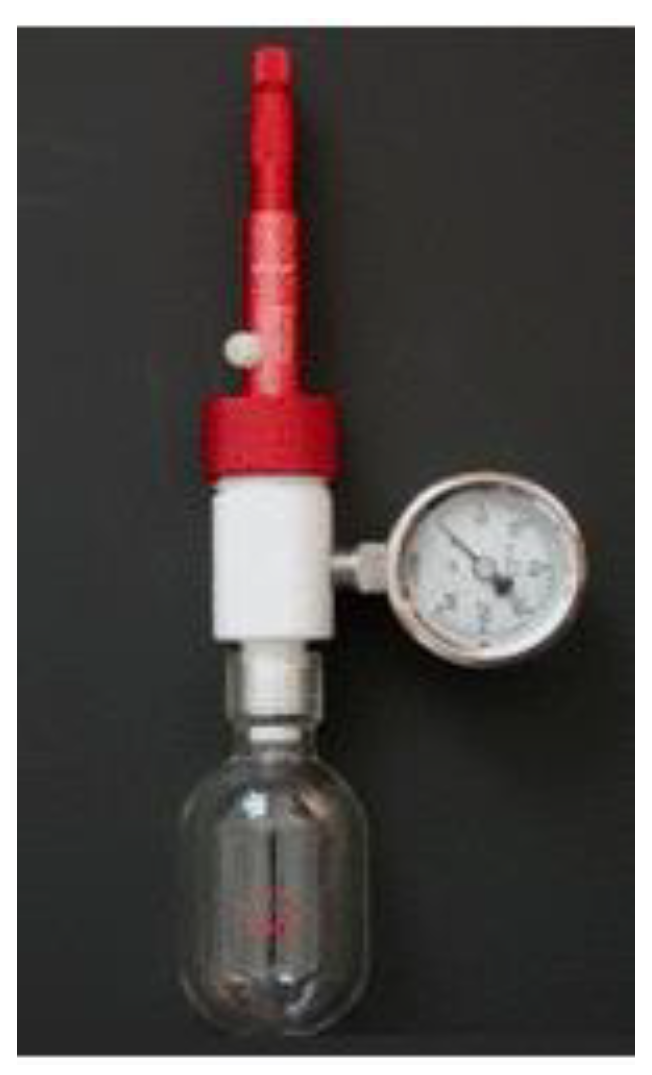
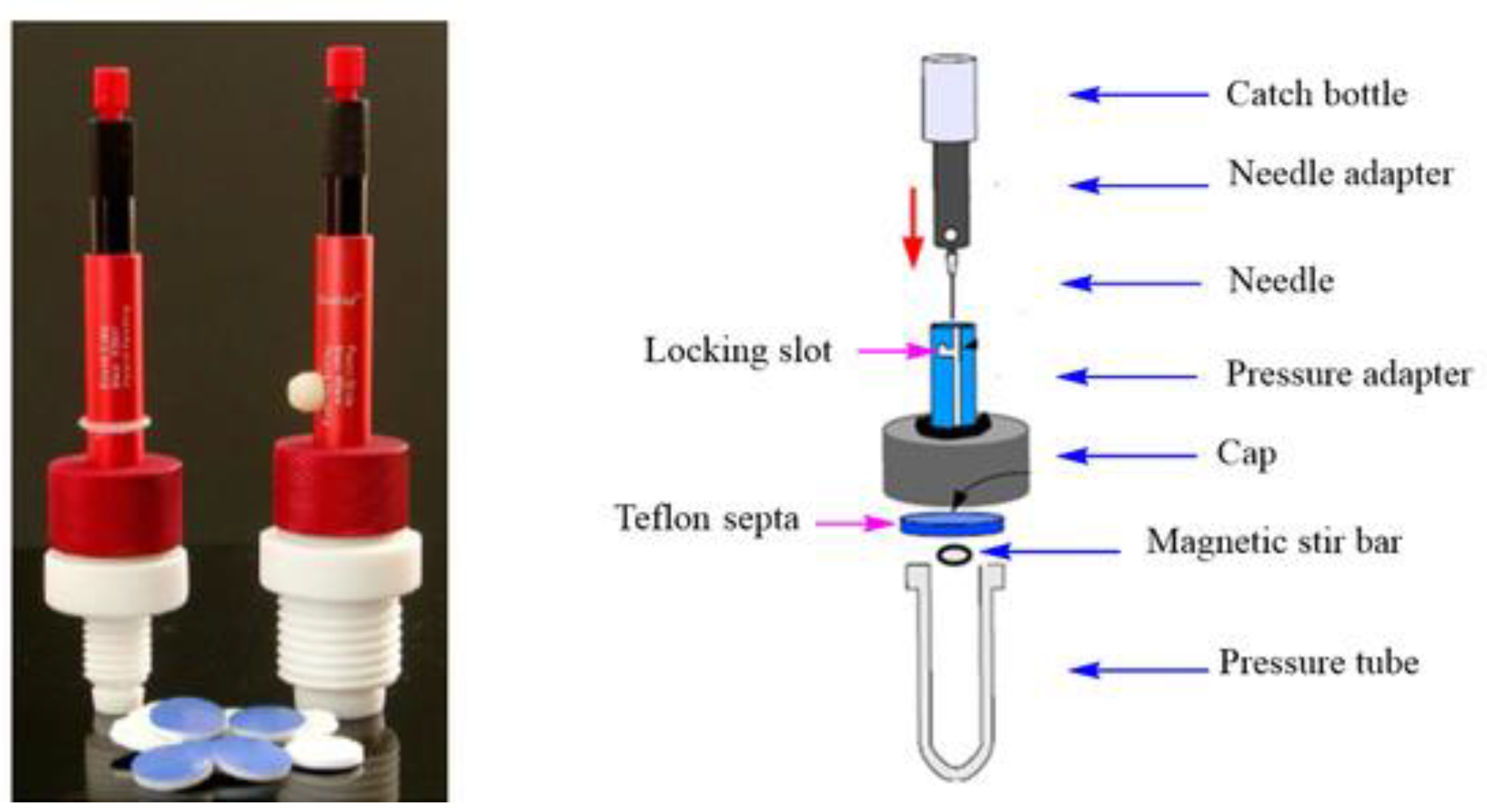



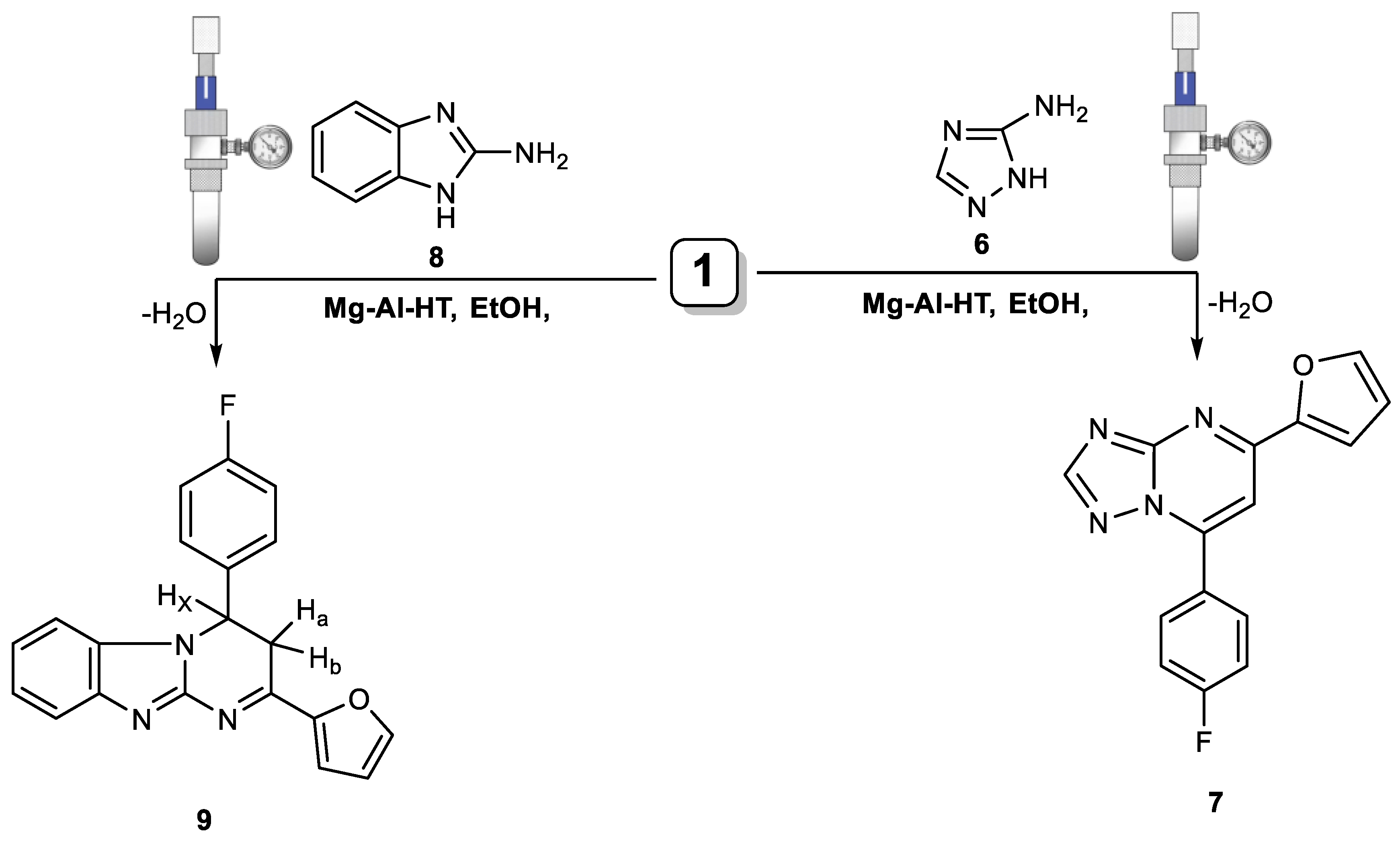
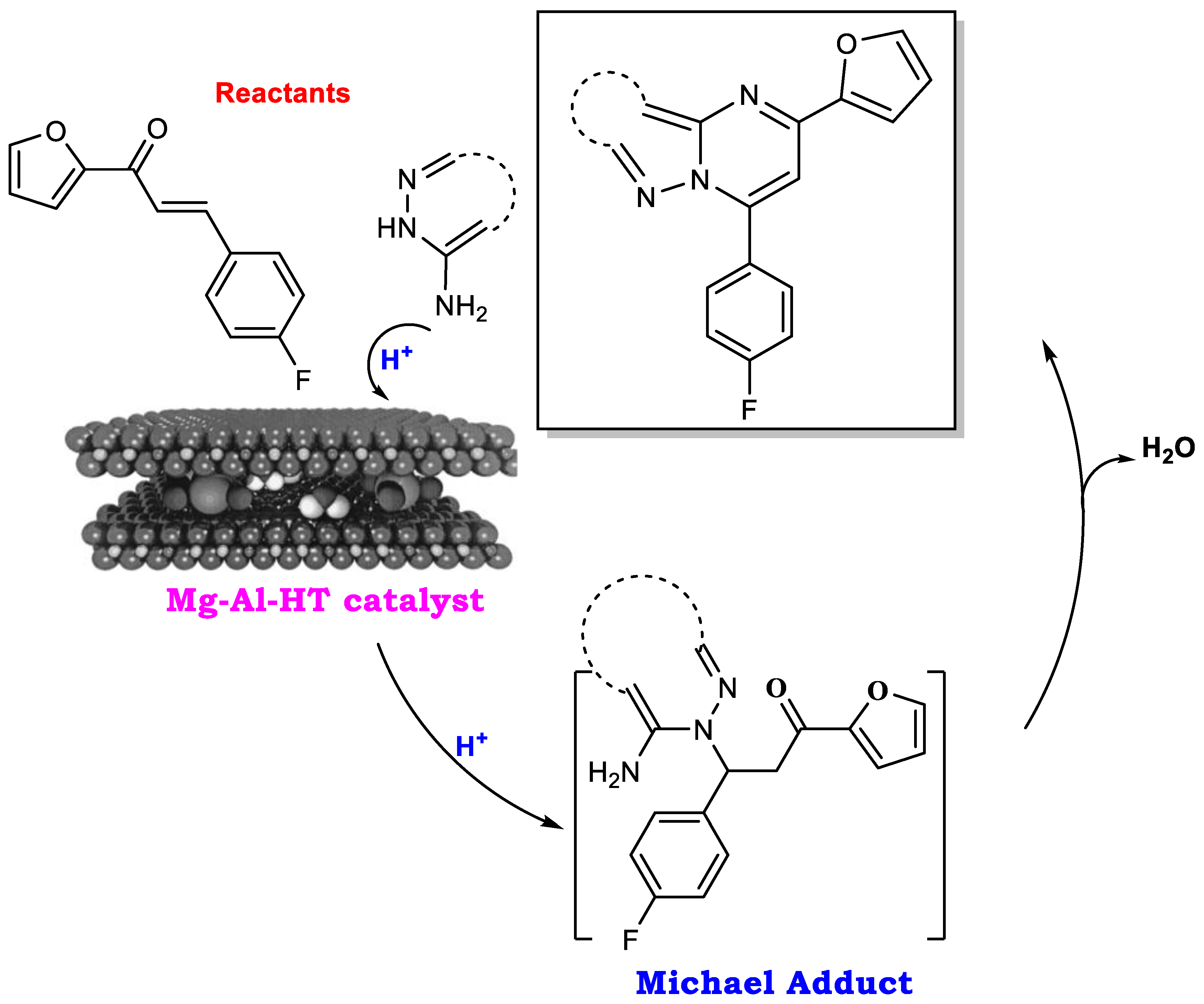
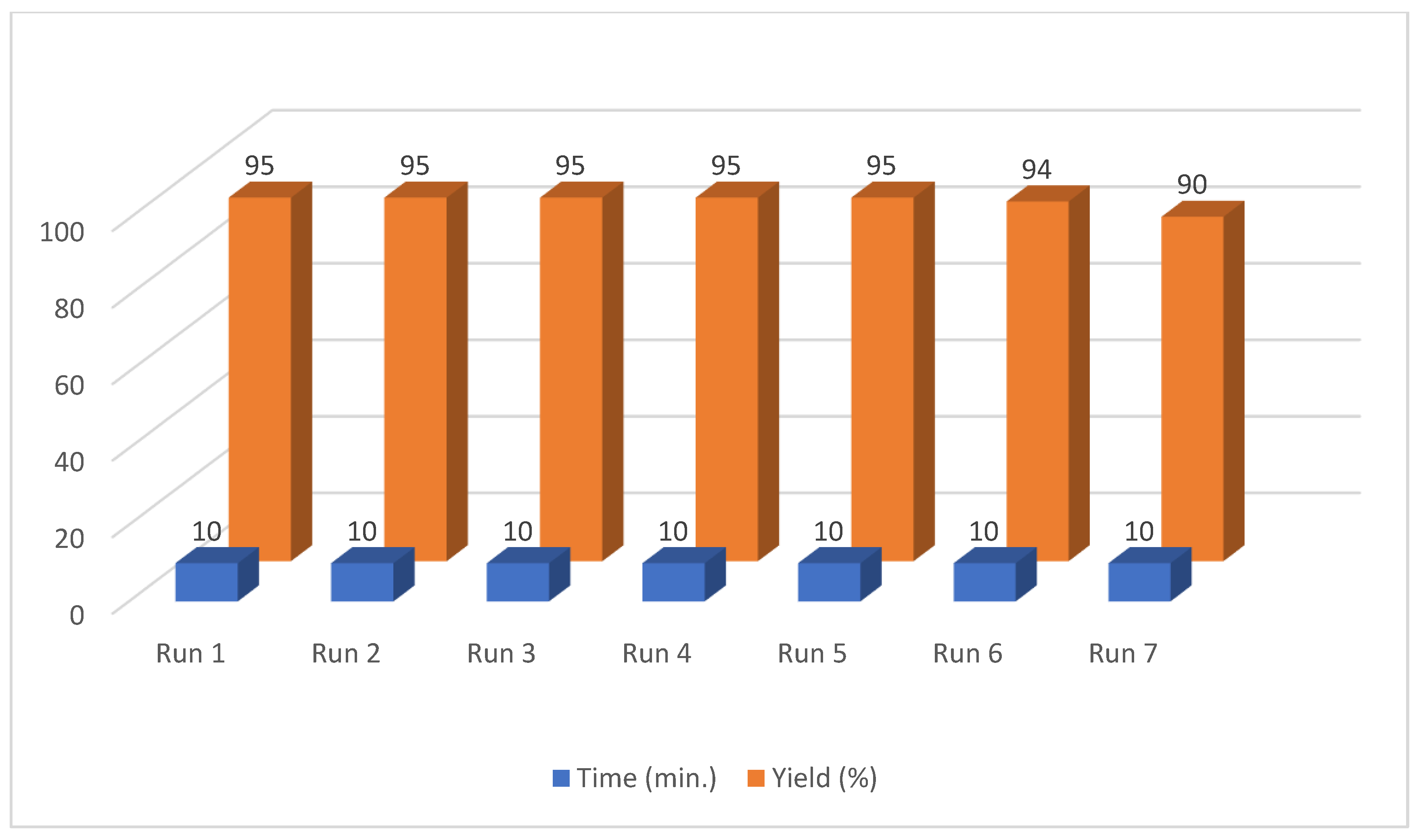
| Entry | Catalyst | (Reflux) * | MW ** | Q-Tube ** | |||
|---|---|---|---|---|---|---|---|
| Yield | Time | Yield | Time | Yield | Time | ||
| 1 | None | 0 | 12 h | 0 | 50 min | 0 | 50 min |
| 2 | K2CO3 | 58% | 12 h | 75% | 40 min | 75% | 40 min |
| 3 | Basic alumina | 61% | 9 h | 84% | 30 min | 82% | 35 min |
| 4 | KF/basic alumina | 68% | 7 h | 88% | 30 min | 85% | 30 min |
| 5 | Mg-Al HT | 77% | 6 h | 96% | 12 min | 95% | 10 min |
Disclaimer/Publisher’s Note: The statements, opinions and data contained in all publications are solely those of the individual author(s) and contributor(s) and not of MDPI and/or the editor(s). MDPI and/or the editor(s) disclaim responsibility for any injury to people or property resulting from any ideas, methods, instructions or products referred to in the content. |
© 2023 by the authors. Licensee MDPI, Basel, Switzerland. This article is an open access article distributed under the terms and conditions of the Creative Commons Attribution (CC BY) license (https://creativecommons.org/licenses/by/4.0/).
Share and Cite
Al-Romaizan, A.N.; Bawaked, S.M.; Saleh, T.S.; Moustafa, M.M.M. The Q-Tube-Assisted Green Sustainable Synthesis of Fused Azines: New Synthetic Opportunities via Innovative Green Technology. Appl. Sci. 2023, 13, 11864. https://doi.org/10.3390/app132111864
Al-Romaizan AN, Bawaked SM, Saleh TS, Moustafa MMM. The Q-Tube-Assisted Green Sustainable Synthesis of Fused Azines: New Synthetic Opportunities via Innovative Green Technology. Applied Sciences. 2023; 13(21):11864. https://doi.org/10.3390/app132111864
Chicago/Turabian StyleAl-Romaizan, Abeer Nasser, Salem M. Bawaked, Tamer S. Saleh, and Mohamed Mokhtar M. Moustafa. 2023. "The Q-Tube-Assisted Green Sustainable Synthesis of Fused Azines: New Synthetic Opportunities via Innovative Green Technology" Applied Sciences 13, no. 21: 11864. https://doi.org/10.3390/app132111864






